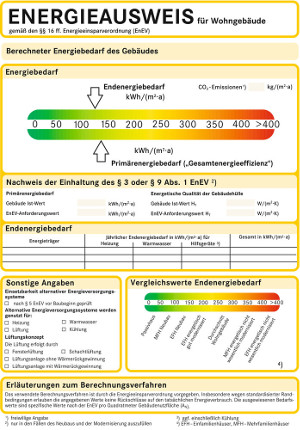When is an energy certificate / energy pass required for existing buildings?
In accordance with the legal stipulations, an energy certificate / energy pass must be presented to a potential tenant / buyer when the property is being viewed. The energy certificate /energy pass is subsequently presented in original form or as a copy after the contract has been signed.
Demand-oriented energy certificate / energy pass
Buildings can be compared in energy terms on the basis of the demand-oriented energy certificate / energy pass. The energy demand of a building is determined on the basis of theoretical calculations. Among other things, data on the type of construction, heating system, ventilation and cooling systems, and energy recovery and regeneration are taken into consideration in the calculations.
A demand-oriented energy certificate / energy pass must be produced for buildings that are to be planned and built, for new buildings for which there are no consumption values available yet, and for properties that had been erected before 1977 and not in accordance with the regulations of the German Wärmeschutzverordnung [Thermal Insulation Ordinance].
Consumption-oriented energy certificate / energy pass
The consumption-oriented energy certificate / energy pass reflects the consumption of a building as affected by the weather, over a chronological axis of at least the last three years.
A consumption-oriented energy certificate / energy pass is required for existing buildings that had been erected in accordance with the German Wärmeschutzverordnung [Thermal Insulation Ordinance] of 11.08.1977 and for buildings that had been renovated in accordance with the requirements of the Wärmeschutzverordnung.
Short analyses (energy checks)
As a first look at the energy situation regarding the building and its technical systems.
Energy consulting on site
Comprehensive analysis of existing buildings, investigation of all the relevant data on the building technical systems, (heating, air conditioning, ventilation) and determining the given user profile, to draw up an individual energy concept while taking into consideration the economic feasibility of all the various possible measures that can be taken.
Thermal insulation certificates
A DIN thermal insulation certificate in compliance with the German EnEV is part of the required documentation for new constructions and is to be submitted to the construction approval authorities together with the planning application and other forms of construction-related certification before work starts.
Heating requirements calculations
In construction technology the heating requirements concern the amount of heat required to maintain a certain room temperature. The heating requirements are specified in watts. The heating requirements are determined according to the location of the building, its type of construction, the transfer of heat through the outer surfaces of the building and the form of usage of the individual rooms. The necessity is oriented towards thermal insulation measures and the design of the heating system on the basis of the heating requirements.

Construction supervision
IAmong other things, the correct implementation and interlinking of the various trades and works, compliance with the qualitative stipulations and the application of the specified economic factors for implementation of the construction measures are monitored as part of the construction supervision.
Drawing up renovation concepts
As a rule, energy or thermal renovation requires the improving of the thermal façade and the optimization of the technical systems (heating, air conditioning, ventilation) of a building to minimize the demand for heating in accordance with the criteria of the energy standards that are to be implemented.
Calculating thermal bridges
A thermal bridge is an area in the components of a building through which the thermal flow (heat) is faster than for that of the adjacent components. The increased transmission of heat by thermal bridges causes these components to have a increased need for heat as a result of a lower interior surface temperature so that there is a risk of mould developing. In addition, there is a risk of condensation and damage to the fabric of the building.
Thermography (thermal images)
Thermography is a procedure in which the surface temperatures of the property is shown by giving a graphic illustration. To do this, the intensity of the infrared radiation that is emitted from a specific point is taken as a reference for its temperature so that any thermal bridges can be shown in graphic form.
Funding measures (KfW, BAFA, EnergieBonusBayern)
Research and verification of current funding programs (KfW, BAFA, EnergieBonusBayern) for construction, renovation, modernisation, energy saving and the use of renewable forms of energy.


